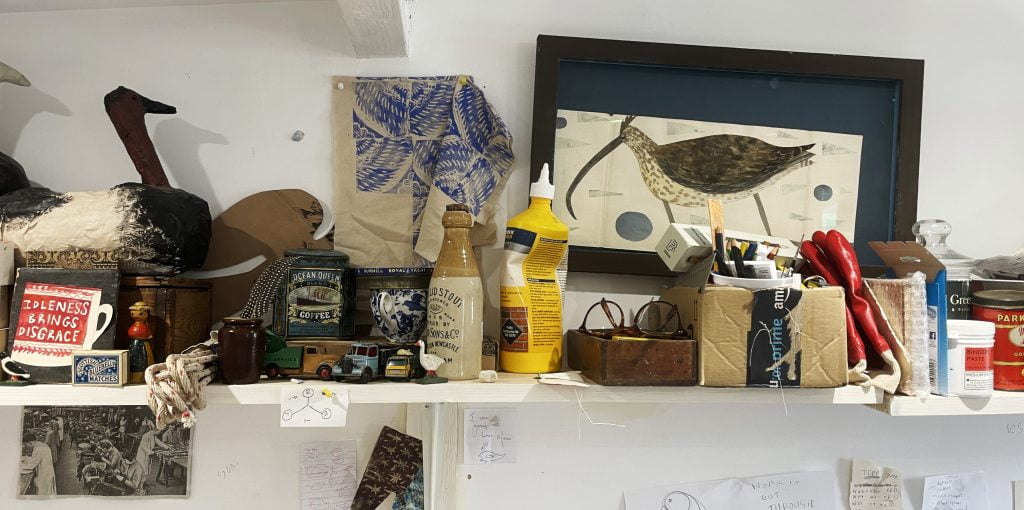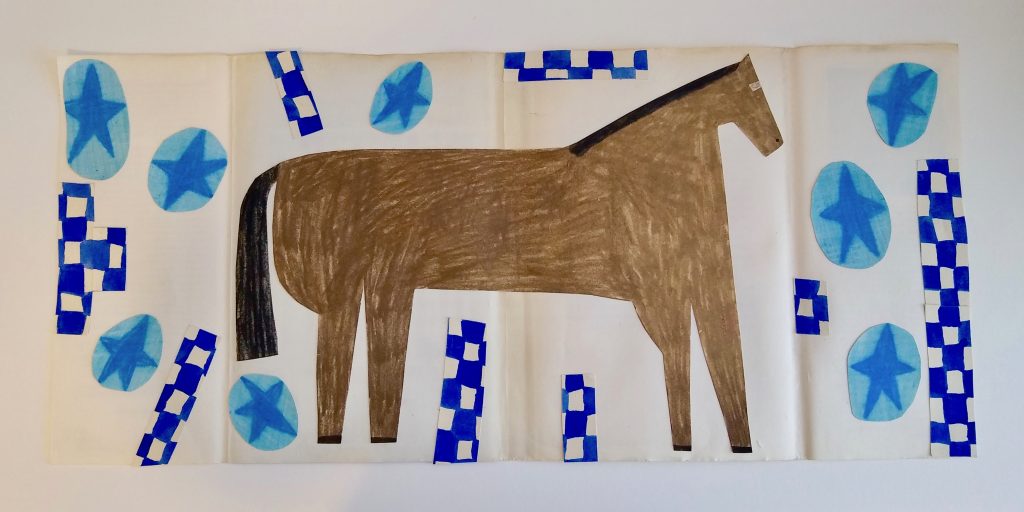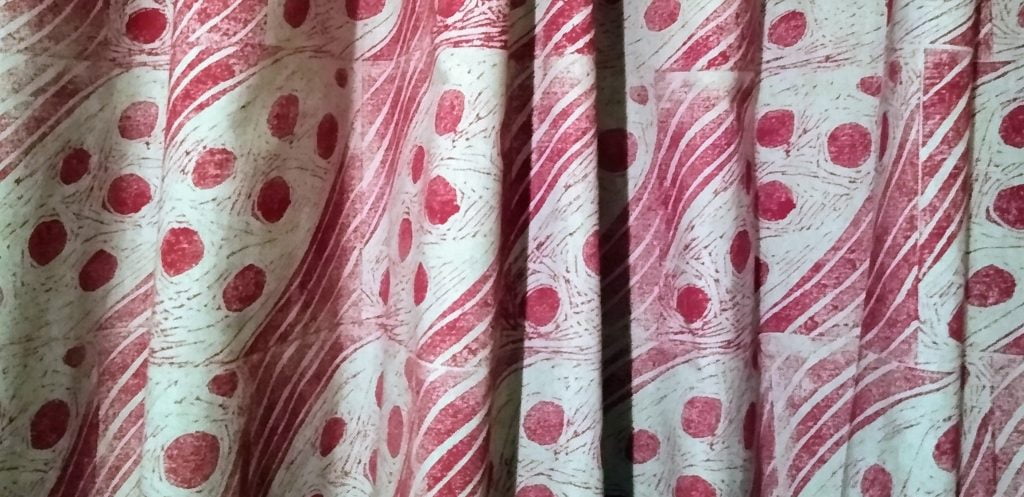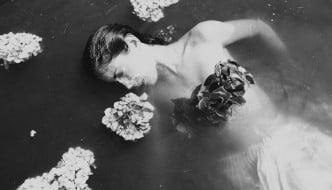Kate Black (b.1981 Walsall, UK) is an artist and illustrator who lives and works in Malton, North Yorkshire. She is a collagist who creates imagery in response to objects and events, inspired by social history, artefacts and artworks found in museum and gallery collections. She’s particularly drawn to British Folk Art, textiles and children’s drawings which comes through in her work.
Her new home studio may have freshly painted white walls but it’s already encrusted in historic objects, vintage school books, packaging, paper and so much more! Court Spencer went to visit Kate and her family in Malton to find out more about her work.

Shelf in Kate’s studio.
Court: Hello. It’s great to finally meet you! After showing your work at The Mercer Open and now working with you on Definitions of Drawing II, it’s so nice to meet you in person. And thank you so much for having me over on a Sunday morning. So first of all, how do you describe yourself? Do you prefer artist or illustrator? And do you see a difference between the two?
Kate: Courtney, thanks very much for the opportunity to be part of the exhibition and for coming to visit us here in Malton, lovely to meet you too! I don’t have a preference as such, I’m interested in visualising and creating imagery in response to stories around objects and places, using the past as something to inspire new work.
Court: Ah, I like that way of thinking about it. Did you always want to work in the arts from a young age?
Kate: I’ve always been very creative and have made things, creativity has been the one consistency in my life which I’m most thankful for. I’ve had many jobs over the years to pay the mortgage but I’ve most enjoyed working in education, museums and galleries.

Studio Shot.
Court: You and Andy were involved in setting up AHH studios here in Malton. How did that come about?
Kate: We were looking for a studio space when we moved to Malton and there wasn’t anything, so we set about finding somewhere. We looked to rent the empty shop spaces in Malton but the rates were too high. So we teamed up with East Street Arts where we used shop windows for projects, but this was not a long term solution. We got together with other artists in the area who were looking for studios (Lynn Waite, Serena Partridge, Sally Taylor and Rachel Renwick), formed a Community Interest Group and rented a building from the council (Wentworth Street Community House which we have rebranded as AHH – Art Happens Here). We are really proud to have been a part of instigating this as it now houses many other artists and has created a community in Malton.
Court: That’s brilliant that you were able to take a proactive approach so much bigger than just finding studio space for yourself but it expanded into finding space for others and creating a supportive community of artists in the area. You’ve recently had this home studio built in the back garden, which is fab! Has it been a big change to have your studio space so close?
Kate: Although the studios at AHH are great, it was challenging finding time to get there to make the work with our jobs and family commitments. We moved out to give other people the opportunity to work there, who would utilise it better. Having the studio in the garden means we can access it more easily and can work late in the night without having to travel.
Court: Yeah, I suppose that’s nice being able to pop in a use your time more effectively. I get the sense that you and Andy have slightly different approaches. I love the wall down the middle to keep you contained! On a really practical level, how did you go about designing the space so it would function for both of you?
Kate: I am very messy and Andy is not! To quote Virginia Woolf one must have ‘ a room of one’s own’. It gives us as much wall space as possible and includes a storage section each.

Kate Black, ‘Horse Jockey Colours number 6’, 2021, Collage .
Court: Oh, I do love your horse series. We had two pieces in The Mercer Open and I saw another at the Trinity Buoy Wharfe Drawing Prize last year. Can you please tell us a bit about where the horses came from?
Kate: I’m interested in Folk Art, stories and lives of the people who surround me and from that of the past. Malton is a thriving market town, which has sheep and cattle markets each week and is home to many horse racing stables and this is what inspired the Horse Series you mention. This series is ongoing, collages of horse shapes and snippets of colour – references to the jockey colours (silks) from horse racing.

Studio shot.
Court: And I’ve just spotted football, birds and flowers! How did these series come about?
Kate: These are some other things I have on the go, the Footballers were part of the Football Art Prize Exhibition, 2021 and the Flowers are part of a commission I did last year for The Shop Floor Project.
Court: Do you primarily work on projects and commissions or is your work more self-guided?
Kate: The work starts out as self-guided, then I have sought funding or people have approached me to commission a series of works, like Curator and Maker, The Shop Floor Project and The Scottish Gallery.

‘Primroses and snowdrops II’, Kate Black (2022).
Court: That’s a great way to stay true to your own values. So what are you working on at the moment?
Kate: I’m making my own wallpaper and curtains at the moment for the house. I’m using potato stamping. I like the link to farming and the process of lino printing – the mismatch of pattern and irregularities of hand printing creates a charm which mass/digital printing cannot.
I’m regularly at car boots and antique fairs to find interesting objects. Summer is brilliant for car boots. I came across a fabulous matchbox collection some time ago, so I’ll probably create more work related to these. I work with different materials, but I see it all as a form of collaging, whether it’s paper, textiles or pieces of wood. Compton Verney Folk Art Collection is an endless source of inspiration, Prize rams in the form of paintings or shop signs, whirligigs, pull along toys, quilts; these are all outlets for stories and ideas.
Court: It’s always so interesting to see the objects that artists surround themselves with in their studios. How do your finds work their way into your art?
Kate: Many ways. I think the home is of central importance to my work, in terms of domesticity and the immediate community being the focus of my attention. I have visited Gwyneth Warren at Magpie Antiques on The Shambles, Malton for over 10 years. Our conversations and our love of objects and antiques has inspired many pieces of work.

Gwyneth Warren, Proprietor of ‘Magpie Antiques’, The Shambles, Malton.
Jim Ede’s collection and approach to showing work within a domestic space at Kettles Yard, Cambridge is another link to the home. Making work that fits in a domestic space and references the everyday in some way, pigeon lofts, chickens on a farm, cuts of meat, I find all of this exciting. When we were in the kitchen earlier, you could see how excited I was over the pink block of carbolic soap! The home is an endless source of inspiration. The Black Country Museum and Beamish Museum are brilliant, I’d live on site if I could! The particularity of objects, the function and design of items from this era, everything is so interesting and inspiring. I’ve made these curtains and printed the design using lino. I really enjoy pattern and design and making things from scratch. I’m the same with cooking – homemade fruit cakes and have a proper brew from our brown betty teapot in a nice bit of blue ware – you can’t beat it in my opinion, it’s all about the simple pleasures.

Curtains in the dining room using Lino printing.
Court: Yeah I can really appreciate the appeal of simple pleasures and taking time to appreciate the time that’s gone into the making process. I love the way you use the inner dust covers from books and how these materials come with a past that makes them so much more interesting. Are these associations important to the work and the way viewers might read it?
Kate: Yes, certainly, I’m attracted to things that look a bit battered, that have a history to them, such as stains and tears of dust jackets or old ledger books, where the paper is aged. Not only does this provide me with a given surface to work on of particular dimensions, but it also provides marks/shapes I can respond to – like a dialogue. I’m always on the lookout for old paper and incorporate this into the collages.
Court: Do you have any dream projects you would like to work on?
Kate: Loads! I would like to work with a publisher to produce a book which features the horse series and includes conversations with individuals from the horse racing community. This would also be an oral history project and include an exhibition of the collages. I saw a wonderful exhibition in Kirbymoorside recently about racing pigeons, it was called ‘View from Without’ based on Kirbymoorside Flying Club. So, something like this, featuring stories from local people alongside the work.
Court: That would be brilliant! And such a nice approach to really give the context of the series by incorporating oral history and preserving it in the form of a beautiful book. You’re showing some of your horse series in Definitions of Drawing II at Sunny Bank Mills, Leeds (5 Aug – 24 Sept). Do you have any other shows coming up? And what’s the best way for people to keep up to date with what you’re doing?
Kate: In September I’m in an exhibition at The Scottish Gallery called ‘Folk at Heart’, an exhibition showcasing artists whose practice stems from Folk Art. And on Instagram, I am kateblack16, there you’ll find what I’m working on and where I’m showing my work. It’s been so lovely chatting with you, we are really looking forward to the exhibition.
Court: Oh thank you. Thank you so much for letting me take up your Sunday morning and for being part of Definitions of Drawing II. It really is so nice to meet you and find out more about your work.
Filed under: Art & Photography
Tagged with: art, artist, collagist, folk, illustrations, Malton, textiles, yorkshire



Comments